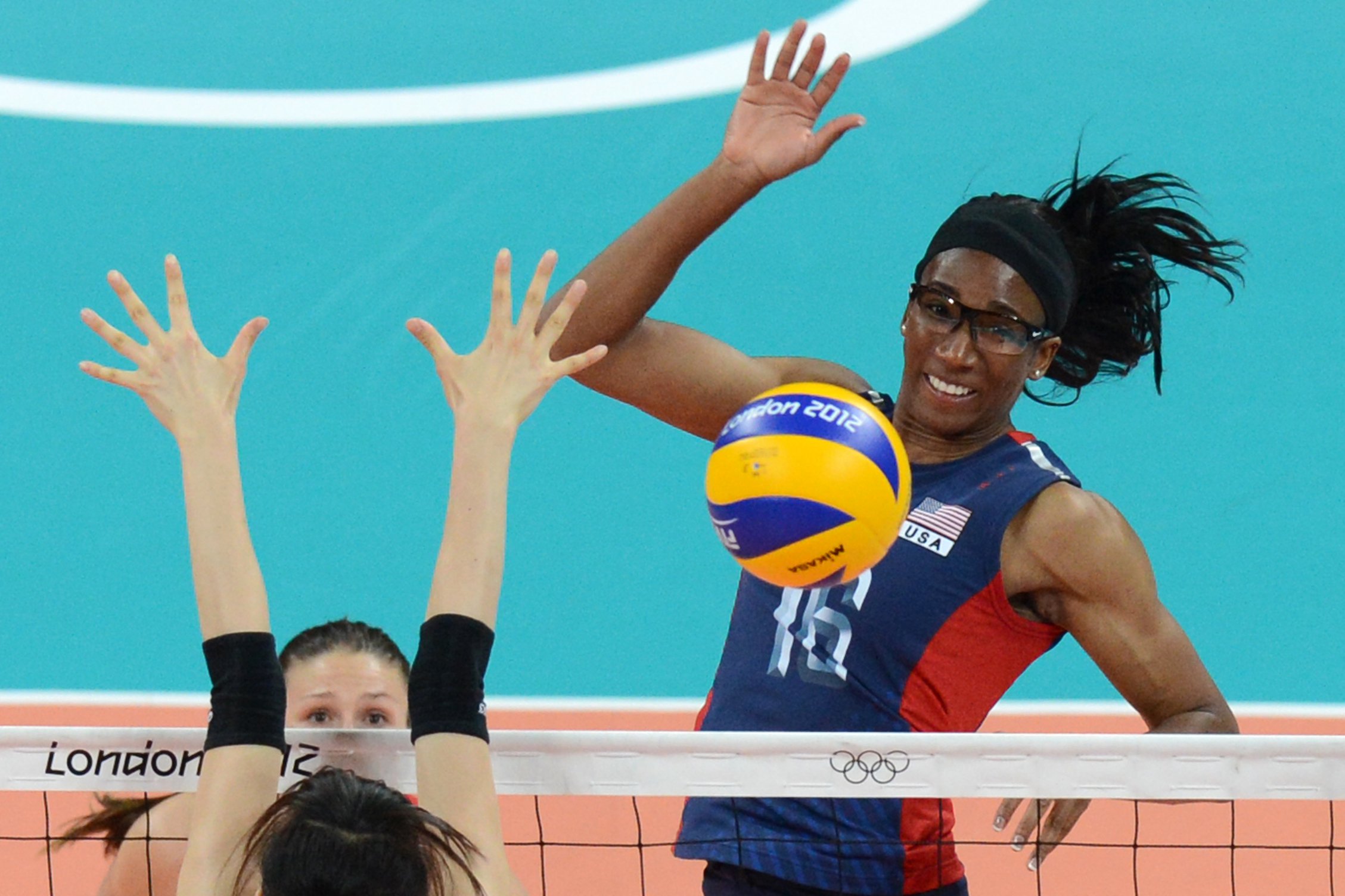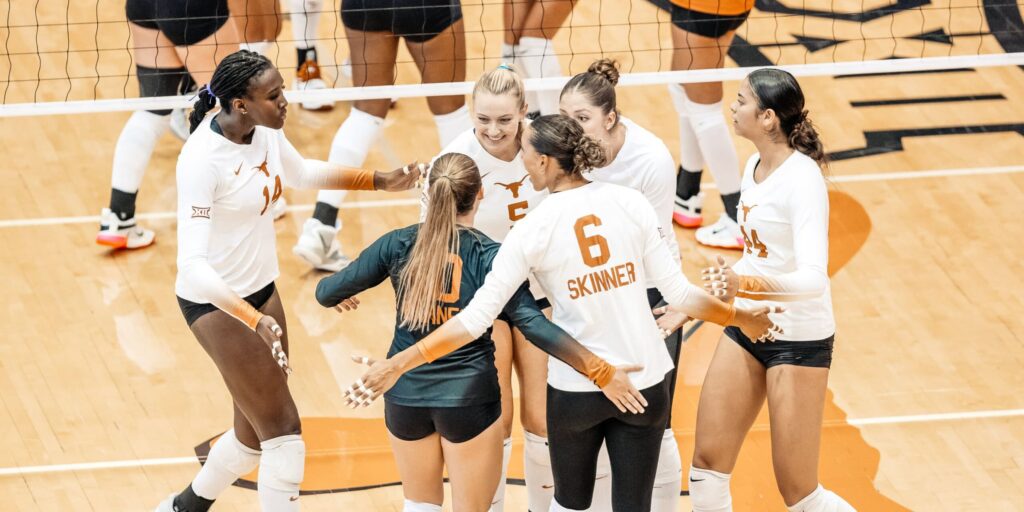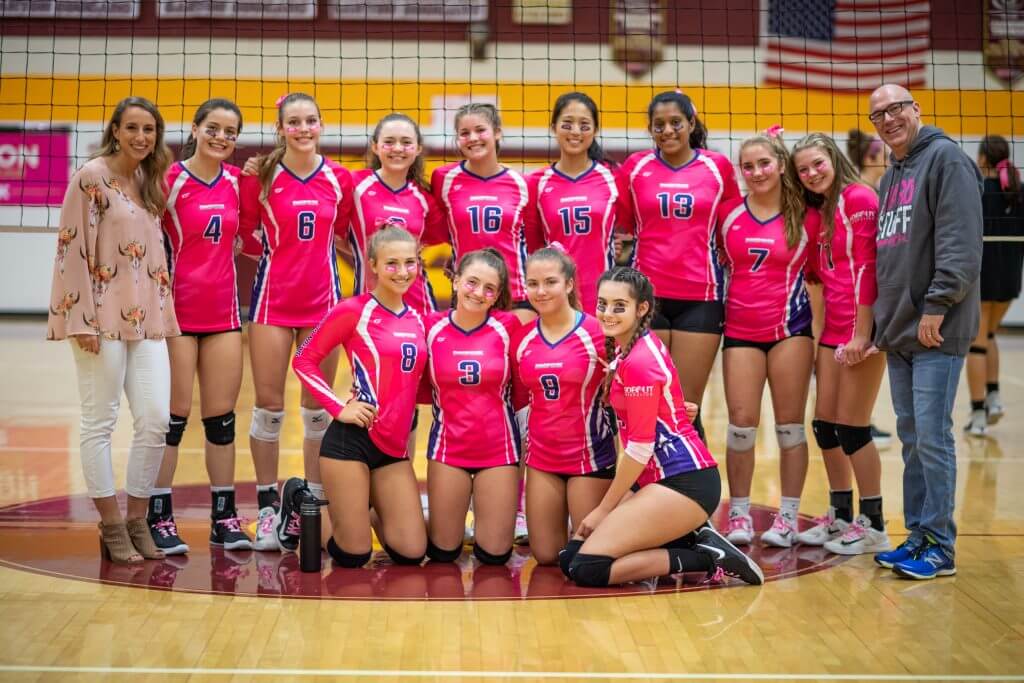Practice time should focus on skills and teamwork. Therefore, improve other parts of your game should be worked on outside of practice. For this reason, we have come up with exercises to improve your hitters’ strength, quickness, and explosiveness.
1. Deadlift
What
To begin here is one of the best total body exercises for strength.
Why
Targets the entire backside (good for jumping!) and, in the long run, is an extremely effective way to get stronger in a short period of time.
Special Equipment
- Kettlebells or Dumbbells or Bands or Barbell with Olympic-style weight plates (see video playlist above to see all of these used)
How-To
- As shown above, place the kettlebell directly underneath the player. His/her ankles should be in line with the handle of the KB.
- Next, hinge hips back with a slight knee bend, shove the hips towards the wall behind the player, the back should remain flat (The best way to describe the starting position is serve-receive)
- Grasp bell handle, initiate by squeezing butt hard and pulling the hips into the hands as the hips and knees straighten at the same time
- Finally, return to start position by initiating with the hips sitting backward and the back remaining flat
Trainer Tips
- Players may try to start the lift by yanking from their backs first- cue them to squeeze their butts first before they even move (tell them to visualize a walnut between the cheeks and they have to crack it). They should use their butt to pull their hips forward instead of pushing up with their legs or cranking through the lower back.
- The hips should slide backward and forwards, not up and down. If you see the hips rising vertically, the player is squatting the weight too much, cue them to sit back towards the wall behind them, as if they were Beyonce. Beyonce on the way back, Michael Jackson on the way up.
- If a player has very long legs and cannot reach the bell without excessively bending the knees, elevated the bell on a mat, weight plate, or some other surface.
2. Reach Roll Lift
What
Keeps players’ shoulders healthy and flexible.
Why
Focuses on the stabilizer muscles around the shoulder blade to keep it in the proper position and prevent injuries.
Special Equipment
- None
How-To
- Drop down to all fours with toes and forearms on the ground. Sit hips back towards the heels.
- Reach one arm forward, palm down, as far as possible.
- Rotate palm to ceiling; lift arm as high as possible without losing crouched position. Hold for 1-2 seconds.
- Lastly, bring the hand down, rotate palm to the floor, and return to starting position.
Trainer Tips
- Keep face pointing towards the floor, do not look up.
3. Scapular Wall Slides
What
Undo all the “forward” shoulder posture.
Why
All in all, it focuses on the stabilizer muscles around the shoulder blade to keep it in the proper position and prevent injuries.
Special Equipment
- A wall
How-To
- Start with head, upper and lower back against the wall; feet should be about 6-8 inches away from the wall; they should all maintain contact with the wall throughout the movement.
- Arms start overhead in a “Y” position with palms facing forward and the backs of the fingers against the wall.
- Maintain finger contact as player bends elbows and slides arms toward ribcage.
- Hold for 1-2 seconds, return to start.
Trainer Tips
- When this position is easy, can move feet closer to the wall.
4. Bear Crawls (Forwards / Backwards)
Bear crawls are great to train your endurance, strength and lose weight at the same time. They also activate your cardiovascular system and improve flexibility.
What
As can be seen, the bear crawl is a surprisingly challenging exercise to improve core, upper and lower body strength and endurance.
Why
Particularly important for the core muscles closest to the spine and hips to be strong to prevent power leaks and injuries to the lower back.
Special Equipment
- 10-40 yards of open space
How-To
- Start on all fours, knees hovering above the ground. Shoulders, hips, and knees should be at 90 degrees and spine should be in its natural curve.
- Second, crawl forward (or backward) by using opposite hand and foot.
- IMPORTANT: try to maintain level hips- meaning, minimize any rocking side-to-side or up and down.
- Challenge: balance a cone or shoe on lower back for the duration of exercise.
Trainer Tips
- If players tell you that these are “too easy” they’re not doing them correctly. All things considered, ensure that the hips stay level and that they are crawling at a deliberate pace.
5. Side Lying Dumbbell External Rotation 30 Degree Abduction
What
In a word, it’s meant for rotator cuff strengthening.
Why
A strong rotator cuff will prevent the upper arm bone from sliding around in the socket too much. In short, it curbs the potential for shoulder injuries and/or irritation.
Special Equipment
- Small towel, dumbbell or small weight plate (2.5-10lbs)
How-To
- Start on the side in a fetal position. The athlete should support head with arm and knees shoulder be stacked; also, hips and knees should be at 90 degrees.
- The top arm should be along the player’s side, elbow at 90 degrees, and the small towel (rolled up) underneath the elbow.
- Starting with palm close to the stomach, rotate upper arm (palm will move in an arch) about 45 degrees relative to the body.
- Finally, return to starting position.
Trainer Tips
- The coach can place fingers just behind the upper arm bone, cue athlete to move from that spot. You should feel the smaller muscles fire. This exercise is easy to cheat on and many players will default to using bigger muscles to make the motion happen. This tactile cue will teach them which muscles to use.
- Do NOT use too much weight!
6. 1-arm Rainbow Med Ball Taps to Wall
What
As shown above, a great way to work on rotator cuff strength and endurance.
Why
Train the rotator cuff at multiple angles as this will help keep the shoulders healthy throughout the season.
Special Equipment
- Train the rotator cuff at multiple angles as this will help keep the shoulders healthy throughout the season.
How-To
- Start about 6-8 inches away from the wall, also face the wall with one arm (with the med ball) overhead.
- Now that you’re in starting position, dribble the ball against the wall continuously as player slowly migrates arm in an arc down the wall. Definitively, the goal is to get the arm as close to parallel to the floor as possible.
- Keep dribbling and return to start position.
Trainer Tips
- Only go as far down as player can control.
- Very few reps per arm are needed (4-6).
7. Push-Ups
What
One of the best bang-for-your-buck exercises to train the whole body with emphasis on the upper body, core, and shoulder stabilizer muscles.
Why
Strong players win, so for this reason, why wouldn’t your players do push-ups?
Special Equipment
- None, possible a box or ledge to elevate hands if needed
How-To
- Start in plank position on the floor on hands with arms extended. Ultimately, the player should be a straight line from head, shoulders, hips, and toes (Tip: you should be able to balance a dowel rod down the midline touching the head, upper back, and tailbone).
- Maintain a tight body position (squeeze abs and butt, HARD) and lower until upper arms are parallel to the floor.
- Keep elbows tucked at 45 degrees relative to the body for healthy shoulders and reduce the risk of pinching something.
- Do not allow hips to sag or head to protrude forward during the movement.
Trainer Tips
CORRECT push-ups are much more difficult than people suspect. More likely than not, your players can do very few (if any) correct push-ups. Here are a few ways to teach and progress the push-ups:
- To begin with, start with hands elevated on a box or ledge. The higher the body angle relative to the floor, the easier the push-up will be. As a player gets stronger, lower the hands incrementally.
- If you don’t have access to boxes or ledges, start players with the negative, or lowering, portion only. Be strict with their form! As a result, learning how to control the negative portion over time will strengthen them to the point that they can add in the concentric, or pushing up, portion.
- Generally speaking, if your players can’t hold a correct (see Starting position for push-up) plank on their hands for 60 seconds, they have no business doing push-ups on the floor.
- Until your players are proficient, keep the number of push-ups per set fairly low, 1-4 reps. However, this doesn’t mean you can’t make them do 8+ sets…
About The Side-Out Foundation
The Side-Out Foundation founder of Dig Pink®, teams with the volleyball community to inspire science and hope in the match against breast cancer. Side-Out is the only charity using the power and teamwork of the volleyball community to beat cancer and is directly responsible for extending the lives of stage 4 breast cancer patients For more information on news, blogs, and events relating to the organization, subscribe to Side-Out’s newsletter. For any additional information, please contact The Side-Out Foundation online.








